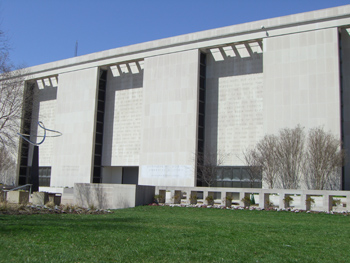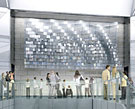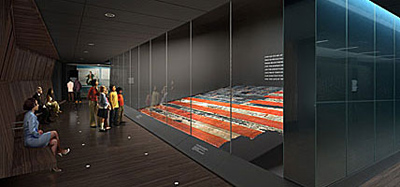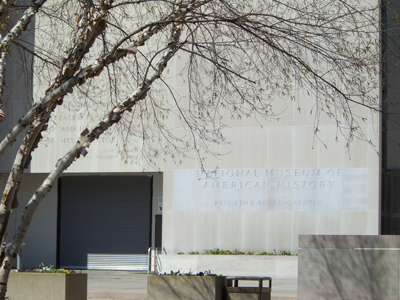
Mall’s American History Museum renews
WASHINGTON, D.C. — The Smithsonian’s National Museum of American History is just as much a part of American history as the artifacts it contains.
But the museum, located on the National Mall on 14th Street and Constitution Avenue N.W., is currently closed for two years to complete its latest renovations.
This is the first time the museum is closed to the public since its opening in 1964, and it should be worth the wait.
 |
The American History Museum on the National Mall in Washington, D.C., is currently undergoing renovations (Photo by Bari Lieberman). |
According to Melinda Machado, director of the Office of Public Affairs, the museum plans to reopen during summer 2008, but an exact date is still pending.
According to released statements, the estimated cost of the renovation project is $85 million, of which $45 million comes from federal funding and the rest will come from previous donations pledged to the museum from philanthropist Kenneth E. Behring and from the Jerome and Dorothy Lemelson Foundation.
Renovations concentrate on three major areas:
- building a modern, sleek gallery for the Star-Spangled Banner
- architectural improvement to the museum’s interior
- additional improvements to the building’s infrastructure and public amenities
“The National Museum of American History will be transformed into a dramatic and bright space to showcase and preserve the Star-Spangled Banner and three million other objects in the national collections,” says Machando. “The design vision is to turn the country’s only national museum of American history into one of the most architecturally striking and distinguished history museums in the world. The museum is modernizing its spaces consistent with and complementary to the original intent and materials of the building.”
The Star-Spangled Banner
 One of the museum’s most popular exhibitions is the 30-by-34-foot wool and cotton American Flag that inspired Francis Scott Key to write the national anthem in 1814 after seeing it still flying over Fort McHenry after British ships bombarded the fort during the War of 1812.
One of the museum’s most popular exhibitions is the 30-by-34-foot wool and cotton American Flag that inspired Francis Scott Key to write the national anthem in 1814 after seeing it still flying over Fort McHenry after British ships bombarded the fort during the War of 1812.
The major challenge in the architectural renovation of this exhibit was to find a way to communicate the flag’s history as well as create a protective barrier for its preservation. The renovations will include dimmer lights and an enclosed display chamber that will help preserve the flag, but also allows for visitors to have the opportunity gain a close-up view of the Star-Spangled Banner.
The design for the exhibition has visitors pass through an entry corridor that presents the basic foundation of the flag’s history. Welcoming visitors to the exhibition will be a contemporary version of the flag, made of lightweight, reflective polycarbonate hanging above the exhibition’s entrance.
The exit corridor from the exhibition will delve into a more detailed history about the flag. Furthermore, the new design will incorporate music, video and virtual technology, allowing visitors to gain a fully hands-on experience and bring the historical flag to life.
| The Star Spangled Banner on display in the museum. The exhibit is among many that will be remodeled (Photo by Bari Lieberman). |  |
Architecture
The museum’s major renovation includes removing the marble panels to create a central “core atrium” and skylight to open the building as well as adding a grand staircase between the first and second floor.
Additionally, 10-foot high “artifact walls” will be added on the first and second floors to display some of the museum’s three million American artifacts. New entrances to the museum are being built on Constitution Avenue and Madison Drive as well as an updated lobby for the Carmichael Auditorium, Visitor’s Center on the second floor and an exhibition gallery for the museum’s Lemelson Center for the Study of Invention and Innovation.
Infrastructure/Public Amenities
In terms of basic infrastructure, the museum’s renovation project will include improvements to elevators, additional restrooms, replacing the heating and air conditioning units, upgrading fire safety devices and improving security.
The National Museum of American History opened as the Museum of History and Technology in 1964 and was originally designed by Walker Cain of McKim, Mead & White. The museum has been through numerous renovations and additions and was renamed the National Museum of American History in 1980.
Architectural firms Skidmore Owings & Merrill LLP (SOM) and Turner Construction are in charge of the overall design for the latest renovation project for the National Museum of American History. According to Machado, the architects were chosen through a competitive federal process.
SOM was also responsible for another building design on the National Mall— the contemporary design of the Hirshhorn Museum and Sculpture Garden— while Turner Construction is currently working on the Newseum Building which is scheduled to open on Oct. 15, 2007. Additionally, Chermayeff & Geismar Inc. will collaborate with SOM for the construction of the Star-Spangled Banner’s permanent gallery.
 |
The museum entrance on the National Mall in Washington, D.C. (Photo by Bari Lieberman). |
Although the museum is closed until the renovations are complete, there are numerous traveling exhibitions including “First Ladies: Political Role and Public Image” as well as “Sports: Breaking Records, Breaking Barriers.”
Additionally, exhibitions are on display at other locations on the National Mall including “Treasures of American History” which can be viewed at the National Air and Space Museum and “Legendary Coins and Currency” at the Smithsonian Castle.
For more information, schedules of the traveling exhibitions and updates about the renovation project, please visit the museum’s website at http://americanhistory.si.edu/ or call 202-633-1000.

Comments are Closed